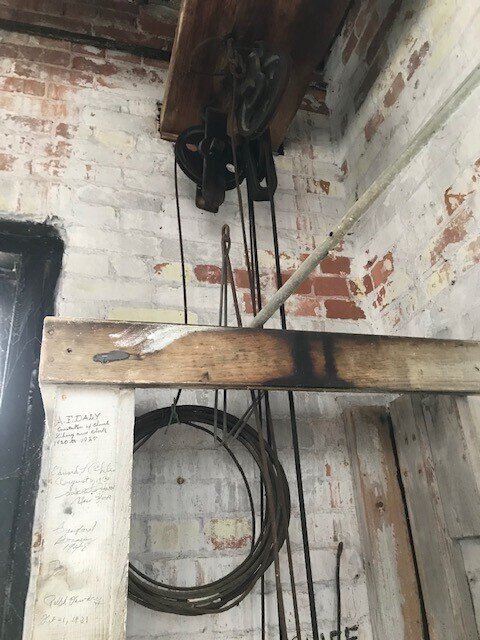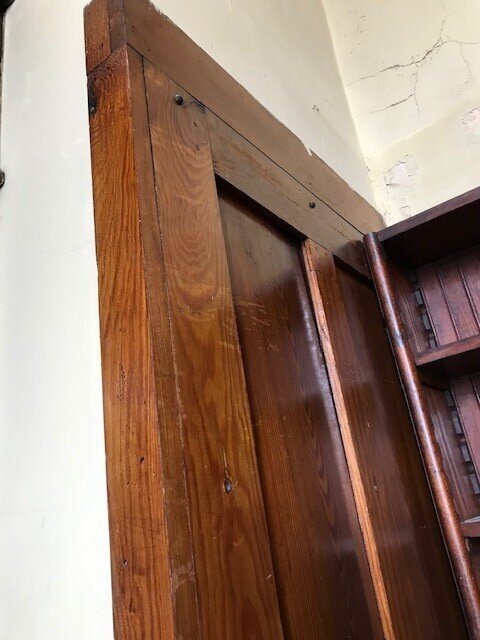Village Clock
By 1899, residents walking back and forth to school, to the post office, to meetings, had developed the habit of checking the steeple clock of the Presbyterian Church, on the corner of Broad and Main Streets, to see if they were in good time. When the first church on that site burned, residents missed this convenience. So the Board of the Village of Sackets Harbor, on November 16, 1899, “Resolved! that this Board, under the authority vested in them by the taxpayers of this village at a special Election called and held pursuant to Law on the 24th day of October 1899, to vote upon the question of purchasing for the village a Tower Clock, do hereby agree to purchase of the E. Howard Watch & Clock Co. of New York, one of their No 1, hour striking, Tower Clocks, arranged for 4 Dials one to be Iron and Glass for illumination, all 5 ft 6 in Diameter, and to bring full tone out of Bell weighing 1600 lbs, all Complete in function and running, in Tower of Presbyterian Church.” Accordingly, on February 27, 1900, it was reported to the Board that the clock had arrived, had been installed, and was running properly.
The four faces of the Village Clock in the tower can be seen from every street entering the intersection. Now, residents leaving the village and coming home still look up at the Village Clock to check the time.
Originally the works were simply mechanical. Perhaps it was the bell-ringer who wound the clock regularly, or perhaps the Village assigned a worker to wind their clock. In either case, a stone weight, in the form of a box of rocks, was part of this process, which you can read about in the next section.
Electricity came to the village circa 1910. The four faces were electrically illuminated from inside. Since the clock was the property of the Village, every few months an accounting of the electricity used by the clock was sent to the Village for reimbursement to the church. Village personnel were responsible for setting the clock to daylight saving time and back twice a year and servicing the lighting.
Now, the Village clock is operated by a computer mounted on the wall of the tower ground floor. The first year the computer was installed and programmed was the same year that Congress moved the start of daylight savings time by two weeks. So, immediately the church received calls that the clock was an hour off. The message was relayed to the Village. It is at such times that we find out how many people check the clock. The computer was reprogrammed and the clock now adjusts on the correct date.
A Box of Rocks
The box of rocks is the weight that was used to drive the Village Clock, before the clock was electrified.
This is a frame around the box of rocks. The three boards sticking out of the bottom are holding the box up, so it doesn’t slide down the weight channel to the floors below.
It would be interesting to find out exactly when the clock was changed from being mechanically to electrically driven, but it was sometime after 1910.
The box today holds a mixed collection of rocks and scrap metal.
The box is connected to a set of pulleys, above, by metal cables.
Clock literature doesn’t call this a box of rocks. The term is “a stone weight.”
At the other end of the room the cable used to go around more pulleys. After that the cables should have gone to a winding drum that took up the cable as the box was drawn up the channel. It seems the clock needed to be wound every three to five days.
This shows the position of the weight channel in relation to the bell-playing console. Over years operation of the clock has been changed from manual to electrical to computer driven. The electrical mechanism still stands, with the bottle of clock oil on top, next to the bell console. The shiny conduit, leading to each clock face from the center, hold to computer cables, now in use.
The weight channel extends down through rooms on the fourth, third and second floors. The second floor has access to the channel, through a hatch framed and finished in woodwork. There are no hinges on the hatch door. It’s screwed shut and blocked by built-in shelving. The channel stops there. It doesn’t extend to the first floor, where the metal, spiral stairs end.

















